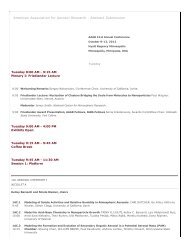Download PDF of Conference Program Book - AAARabstracts
Download PDF of Conference Program Book - AAARabstracts
Download PDF of Conference Program Book - AAARabstracts
- No tags were found...
Create successful ePaper yourself
Turn your PDF publications into a flip-book with our unique Google optimized e-Paper software.
equilibrium and the water uptake <strong>of</strong> soluble aerosol<br />
components in response to temperature and relative<br />
humidity changes. This course will cover the following<br />
fundamentals: the water uptake <strong>of</strong> different soluble<br />
components <strong>of</strong> aerosols, including organic compounds;<br />
the precipitation <strong>of</strong> solid phases and metastable equilibria;<br />
the Phase Rule; Henry’s law; activity coefficients and<br />
deviations from ideal solution behavior; the Kelvin effect;<br />
and the role <strong>of</strong> surfactants. We will also discuss the<br />
application <strong>of</strong> thermodynamic principles used to describe<br />
the formation <strong>of</strong> cloud droplets (via absorption and<br />
adsorption <strong>of</strong> water vapor), and present semi-empirical<br />
frameworks used for describing the cloud condensation<br />
nuclei (CCN) properties <strong>of</strong> atmospheric aerosol.<br />
Athanasios Nenes is an associate pr<strong>of</strong>essor in the<br />
Schools <strong>of</strong> Earth and Atmospheric Sciences and<br />
Chemical and Biomolecular Engineering at the Georgia<br />
Institute <strong>of</strong> Technology. He received a diploma in<br />
chemical engineering from the National Technical<br />
University <strong>of</strong> Athens (Greece), a masters degree in<br />
atmospheric chemistry from the Rosenstiel School <strong>of</strong><br />
Marine and Atmospheric Sciences and a doctorate in<br />
chemical engineering from the California Institute <strong>of</strong><br />
Technology. He is the developer <strong>of</strong> the ISORROPIA aerosol<br />
thermodynamic model and co-inventor <strong>of</strong> the Continuous<br />
Flow Streamwise Thermal Gradient CCN Chamber. He<br />
has received the Friedlander Award <strong>of</strong> the AAAR and the<br />
Henry G. Houghton Award <strong>of</strong> the AMS.<br />
3. prInCIpleS <strong>of</strong> BIoAeroSol<br />
SAMplInG And AnAlySIS<br />
Gediminas “Gedi” Mainelis, Department <strong>of</strong><br />
Environmental Sciences, Rutgers University, New<br />
Brunswick, NJ<br />
Abstract: Bioaerosols include viruses, bacteria, fungi,<br />
pollen and their products. Biological particles can range<br />
from nanometers to microns in size. Bioaerosols are<br />
produced naturally, as a byproduct <strong>of</strong> various activities,<br />
or can be released intentionally to harm populations.<br />
Sampling and detection <strong>of</strong> bioaerosols are important<br />
for environmental and indoor studies, exposure<br />
assessment, manufacturing quality control and protection<br />
<strong>of</strong> populations from intentionally released agents. The<br />
same physical principles that are applied to collect<br />
www.AAAR.org<br />
Tutorials<br />
29



